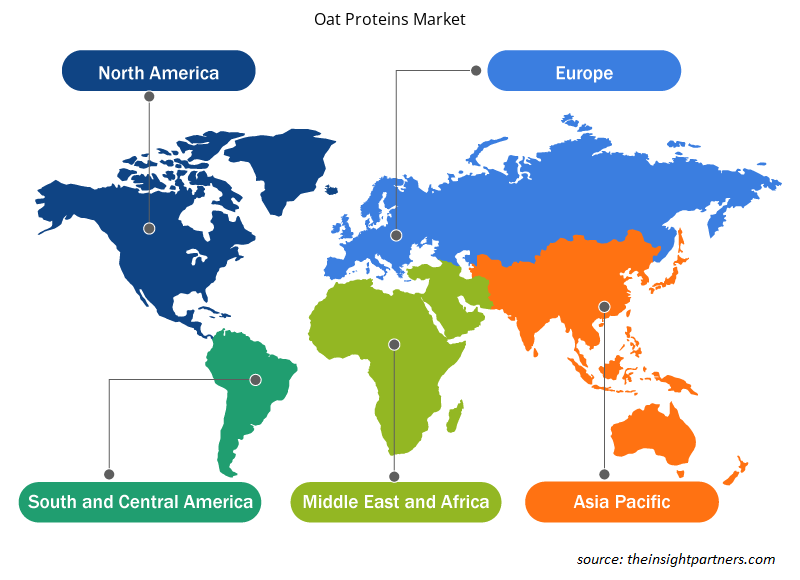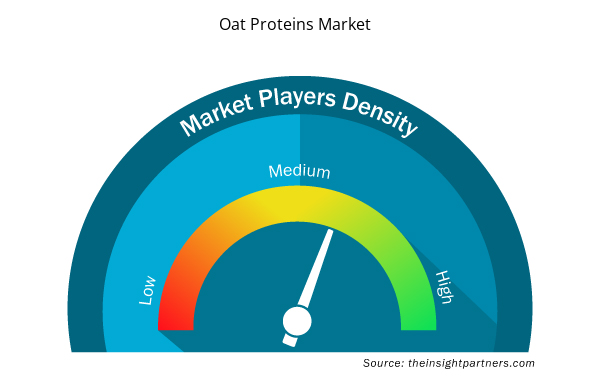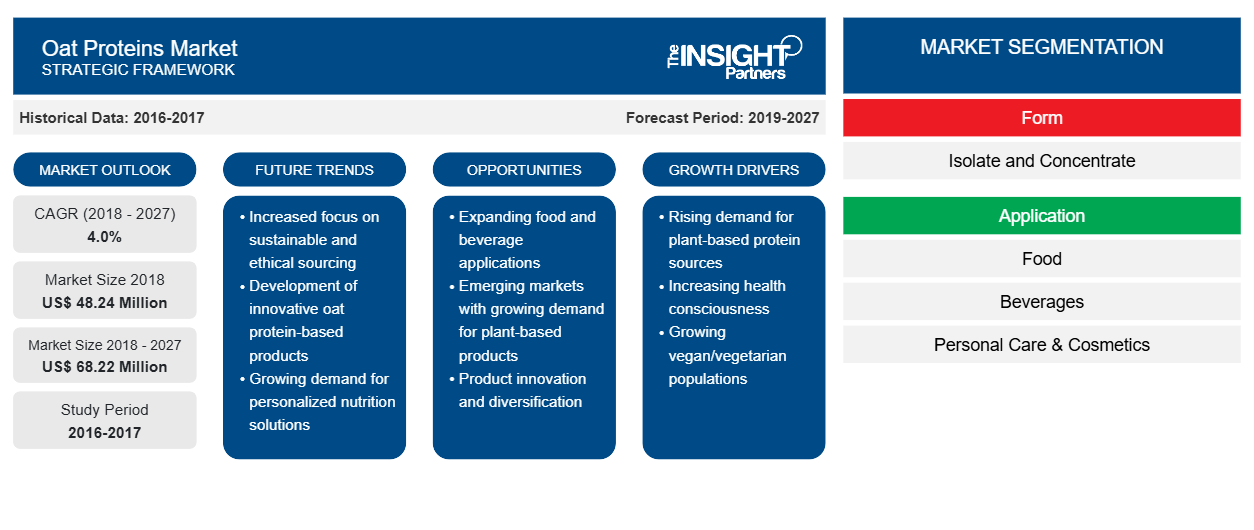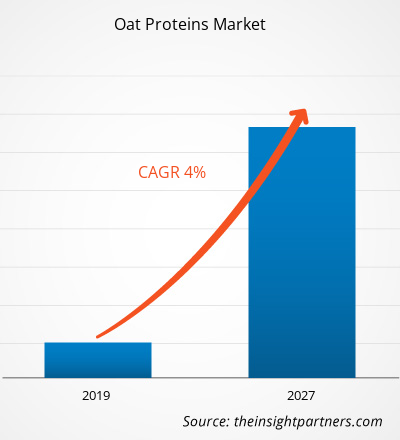Der Markt für Haferproteine hatte im Jahr 2018 einen Wert von 48.241.100 USD und dürfte im Prognosezeitraum 2019–2027 mit einer durchschnittlichen jährlichen Wachstumsrate von 4,0 % wachsen und bis 2027 einen Wert von 68.222.400 USD erreichen.
Die Region Europa hatte den größten Anteil am globalen Markt für Haferproteine . Das Wachstum des Marktes in dieser Region ist in erster Linie auf die wachsende Lebensmittel- und Getränkeindustrie in Ländern wie Italien, Frankreich und Großbritannien zurückzuführen. Darüber hinaus verfügt Europa über eine gut etablierte Kosmetikindustrie, und die Nachfrage nach natürlichen Inhaltsstoffen in der Kosmetikindustrie ist in den letzten Jahren gestiegen. Dieser Faktor wird voraussichtlich die Nachfrage nach Haferprotein ankurbeln. Das zunehmende Bewusstsein für die gesundheitlichen Vorteile von Haferprotein in Verbindung mit einem Anstieg der Nachfrage nach pflanzlichem Protein sind die Hauptfaktoren, die den Haferproteinmarkt in Europa ankurbeln. Unternehmen wie Harke Group und Lantmännen sind in den europäischen Regionen stark vertreten. Diese Faktoren haben zum Wachstum des Haferproteinmarktes in der Region Europa geführt.
Markteinblicke
Die gesundheitlichen Vorteile des Haferproteinkonsums haben zum Wachstum des Haferproteinmarktes geführt
Protein ist ein wesentlicher Bestandteil der Ernährung und spielt eine wesentliche Rolle in den strukturellen und funktionellen Komponenten des menschlichen Körpers. Haferprotein wird aus Haferkörnern hergestellt und enthält erhebliche Mengen an essentiellen Aminosäuren, insbesondere die verzweigtkettigen Aminosäuren (BCAAs) Leucin, Isoleucin und Valin. Dies sind essentielle Nährstoffe, die für das Muskelwachstum und die Muskelreparatur bei Menschen jeden Alters wichtig sind. Haferprotein enthält mehr schwefelhaltige Aminosäuren (SAA) und Tryptophan als Erbsenprotein und eine hohe Menge an schwefelhaltigen Aminosäuren (SAA) und Valin als Sojaprotein. Es enthält mehr essentielle Aminosäuren als Weizenprotein. Mehrere Forschungsstudien weisen darauf hin, dass Haferprotein ein Sättigungsgefühl hervorrufen und so zur Aufrechterhaltung des Körpergewichts beitragen kann. Daher haben wachsende Gesundheitsbedenken und ein zunehmender Fokus auf die Gesundheit zum Wachstum des Haferproteinmarktes geführt.
Passen Sie diesen Bericht Ihren Anforderungen an
Sie erhalten kostenlose Anpassungen an jedem Bericht, einschließlich Teilen dieses Berichts oder einer Analyse auf Länderebene, eines Excel-Datenpakets sowie tolle Angebote und Rabatte für Start-ups und Universitäten.
- Holen Sie sich die wichtigsten Markttrends aus diesem Bericht.Dieses KOSTENLOSE Beispiel umfasst eine Datenanalyse von Markttrends bis hin zu Schätzungen und Prognosen.
Regionale Einblicke in den Markt für Haferproteine
Die regionalen Trends und Faktoren, die den Markt für Haferproteine im Prognosezeitraum beeinflussen, wurden von den Analysten von Insight Partners ausführlich erläutert. In diesem Abschnitt werden auch die Marktsegmente und die Geografie für Haferproteine in Nordamerika, Europa, im asiatisch-pazifischen Raum, im Nahen Osten und Afrika sowie in Süd- und Mittelamerika erörtert.

- Holen Sie sich die regionalen Daten zum Haferproteinmarkt
Umfang des Marktberichts zu Haferproteinen
| Berichtsattribut | Details |
|---|---|
| Marktgröße im Jahr 2018 | 48,24 Millionen US-Dollar |
| Marktgröße bis 2027 | 68,22 Millionen US-Dollar |
| Globale CAGR (2018 - 2027) | 4,0 % |
| Historische Daten | 2016-2017 |
| Prognosezeitraum | 2019–2027 |
| Abgedeckte Segmente | Nach Formular
|
| Abgedeckte Regionen und Länder | Nordamerika
|
| Marktführer und wichtige Unternehmensprofile |
|
Dichte der Marktteilnehmer für Haferproteine: Die Auswirkungen auf die Geschäftsdynamik verstehen
Der Markt für Haferproteine wächst rasant, angetrieben durch die steigende Nachfrage der Endverbraucher aufgrund von Faktoren wie sich entwickelnden Verbraucherpräferenzen, technologischen Fortschritten und einem größeren Bewusstsein für die Vorteile des Produkts. Mit steigender Nachfrage erweitern Unternehmen ihr Angebot, entwickeln Innovationen, um die Bedürfnisse der Verbraucher zu erfüllen, und nutzen neue Trends, was das Marktwachstum weiter ankurbelt.
Die Marktteilnehmerdichte bezieht sich auf die Verteilung der Firmen oder Unternehmen, die in einem bestimmten Markt oder einer bestimmten Branche tätig sind. Sie gibt an, wie viele Wettbewerber (Marktteilnehmer) in einem bestimmten Marktraum im Verhältnis zu seiner Größe oder seinem gesamten Marktwert präsent sind.
Die wichtigsten auf dem Haferproteinmarkt tätigen Unternehmen sind:
- Harke-Gruppe
- Lantmannen
- Provital-Gruppe
- Croda International Plc
- Oat Tech, Inc.
Haftungsausschluss : Die oben aufgeführten Unternehmen sind nicht in einer bestimmten Reihenfolge aufgeführt.

- Überblick über die wichtigsten Akteure auf dem Markt für Haferproteine
Strategische Marktinitiativen wie die Expansion haben sich positiv auf das Wachstum des globalen Haferproteinmarktes ausgewirkt. Die jüngste Entwicklung auf dem globalen Haferproteinmarkt ist nachstehend aufgeführt:
- 2019: Die Fazer Group hat ihre Wachstumsstrategie umgesetzt und Kaslink übernommen, einen Experten für Haferprodukte.
- 2018: Lantmännen übernimmt das im schwedischen Kimstad ansässige Haferzutatengeschäft von Tate & Lyle PLC. Dazu gehören eine Hafermühle mit einer Kapazität von 55.000 Tonnen und eine Produktionsanlage für Haferzutaten, in der Haferprotein, Beta-Glucan und Hafermehl hergestellt werden.
- 2015: Fazer investierte in die Expansion des finnischen Hafers und gab fünf Millionen Euro für die Erweiterung der Hafermühle in Lahti aus.
Globaler Markt für Haferproteine – nach Form
- Isolieren
- Konzentrieren
Globaler Haferproteinmarkt – nach Anwendung
- Essen
- Getränke
- Körperpflege & Kosmetik
- Andere
Globaler Markt für Haferproteine – nach Geografie
Nordamerika
- UNS
- Kanada
- Mexiko
Europa
- Deutschland
- Frankreich
- Vereinigtes Königreich
- Italien
- Russland
- Restliches Europa
Asien-Pazifik (APAC)
- China
- Australien
- Indien
- Japan
- Restlicher Asien-Pazifik-Raum
Naher Osten und Afrika (MEA)
- Südafrika
- Saudi-Arabien
- Vereinigte Arabische Emirate
- Rest von MEA
Südamerika
- Brasilien
- Argentinien
- Rest von SAM
Firmenprofile
- Croda International Plc
- Givaudan SA
- Harke Group
- Lantmannen.
- Lonza Group
- Oat Tech, Inc.
- Oy Karl Fazer Ab
- Provital-Gruppe
- Shaanxi Pioneer Biotech Co., Ltd
- Shanghai Cosroma Biotech Co., LTD
- Historische Analyse (2 Jahre), Basisjahr, Prognose (7 Jahre) mit CAGR
- PEST- und SWOT-Analyse
- Marktgröße Wert/Volumen – Global, Regional, Land
- Branche und Wettbewerbsumfeld
- Excel-Datensatz


- Electronic Toll Collection System Market
- Small Internal Combustion Engine Market
- Battery Testing Equipment Market
- Joint Pain Injection Market
- Drain Cleaning Equipment Market
- Parking Management Market
- Space Situational Awareness (SSA) Market
- Nurse Call Systems Market
- Wheat Protein Market
- Public Key Infrastructure Market

Report Coverage
Revenue forecast, Company Analysis, Industry landscape, Growth factors, and Trends

Segment Covered
This text is related
to segments covered.

Regional Scope
North America, Europe, Asia Pacific, Middle East & Africa, South & Central America

Country Scope
This text is related
to country scope.
Trends and growth analysis reports related to Food and Beverages : READ MORE..
The List of Companies
- Harke group
- Lantmannen
- Provital Group
- Croda International Plc
- Oat Tech, Inc.
- Oy Karl Fazer Ab
- Givaudan S.A.
- Lonza Group
- Shaanxi Pioneer Biotech Co., Ltd.
- Shanghai Cosroma Biotech Co., LTD.
The Insight Partners performs research in 4 major stages: Data Collection & Secondary Research, Primary Research, Data Analysis and Data Triangulation & Final Review.
- Data Collection and Secondary Research:
As a market research and consulting firm operating from a decade, we have published and advised several client across the globe. First step for any study will start with an assessment of currently available data and insights from existing reports. Further, historical and current market information is collected from Investor Presentations, Annual Reports, SEC Filings, etc., and other information related to company’s performance and market positioning are gathered from Paid Databases (Factiva, Hoovers, and Reuters) and various other publications available in public domain.
Several associations trade associates, technical forums, institutes, societies and organization are accessed to gain technical as well as market related insights through their publications such as research papers, blogs and press releases related to the studies are referred to get cues about the market. Further, white papers, journals, magazines, and other news articles published in last 3 years are scrutinized and analyzed to understand the current market trends.
- Primary Research:
The primarily interview analysis comprise of data obtained from industry participants interview and answers to survey questions gathered by in-house primary team.
For primary research, interviews are conducted with industry experts/CEOs/Marketing Managers/VPs/Subject Matter Experts from both demand and supply side to get a 360-degree view of the market. The primary team conducts several interviews based on the complexity of the markets to understand the various market trends and dynamics which makes research more credible and precise.
A typical research interview fulfils the following functions:
- Provides first-hand information on the market size, market trends, growth trends, competitive landscape, and outlook
- Validates and strengthens in-house secondary research findings
- Develops the analysis team’s expertise and market understanding
Primary research involves email interactions and telephone interviews for each market, category, segment, and sub-segment across geographies. The participants who typically take part in such a process include, but are not limited to:
- Industry participants: VPs, business development managers, market intelligence managers and national sales managers
- Outside experts: Valuation experts, research analysts and key opinion leaders specializing in the electronics and semiconductor industry.
Below is the breakup of our primary respondents by company, designation, and region:

Once we receive the confirmation from primary research sources or primary respondents, we finalize the base year market estimation and forecast the data as per the macroeconomic and microeconomic factors assessed during data collection.
- Data Analysis:
Once data is validated through both secondary as well as primary respondents, we finalize the market estimations by hypothesis formulation and factor analysis at regional and country level.
- Macro-Economic Factor Analysis:
We analyse macroeconomic indicators such the gross domestic product (GDP), increase in the demand for goods and services across industries, technological advancement, regional economic growth, governmental policies, the influence of COVID-19, PEST analysis, and other aspects. This analysis aids in setting benchmarks for various nations/regions and approximating market splits. Additionally, the general trend of the aforementioned components aid in determining the market's development possibilities.
- Country Level Data:
Various factors that are especially aligned to the country are taken into account to determine the market size for a certain area and country, including the presence of vendors, such as headquarters and offices, the country's GDP, demand patterns, and industry growth. To comprehend the market dynamics for the nation, a number of growth variables, inhibitors, application areas, and current market trends are researched. The aforementioned elements aid in determining the country's overall market's growth potential.
- Company Profile:
The “Table of Contents” is formulated by listing and analyzing more than 25 - 30 companies operating in the market ecosystem across geographies. However, we profile only 10 companies as a standard practice in our syndicate reports. These 10 companies comprise leading, emerging, and regional players. Nonetheless, our analysis is not restricted to the 10 listed companies, we also analyze other companies present in the market to develop a holistic view and understand the prevailing trends. The “Company Profiles” section in the report covers key facts, business description, products & services, financial information, SWOT analysis, and key developments. The financial information presented is extracted from the annual reports and official documents of the publicly listed companies. Upon collecting the information for the sections of respective companies, we verify them via various primary sources and then compile the data in respective company profiles. The company level information helps us in deriving the base number as well as in forecasting the market size.
- Developing Base Number:
Aggregation of sales statistics (2020-2022) and macro-economic factor, and other secondary and primary research insights are utilized to arrive at base number and related market shares for 2022. The data gaps are identified in this step and relevant market data is analyzed, collected from paid primary interviews or databases. On finalizing the base year market size, forecasts are developed on the basis of macro-economic, industry and market growth factors and company level analysis.
- Data Triangulation and Final Review:
The market findings and base year market size calculations are validated from supply as well as demand side. Demand side validations are based on macro-economic factor analysis and benchmarks for respective regions and countries. In case of supply side validations, revenues of major companies are estimated (in case not available) based on industry benchmark, approximate number of employees, product portfolio, and primary interviews revenues are gathered. Further revenue from target product/service segment is assessed to avoid overshooting of market statistics. In case of heavy deviations between supply and demand side values, all thes steps are repeated to achieve synchronization.
We follow an iterative model, wherein we share our research findings with Subject Matter Experts (SME’s) and Key Opinion Leaders (KOLs) until consensus view of the market is not formulated – this model negates any drastic deviation in the opinions of experts. Only validated and universally acceptable research findings are quoted in our reports.
We have important check points that we use to validate our research findings – which we call – data triangulation, where we validate the information, we generate from secondary sources with primary interviews and then we re-validate with our internal data bases and Subject matter experts. This comprehensive model enables us to deliver high quality, reliable data in shortest possible time.


 Holen Sie sich ein kostenloses Muster für diesen Bericht
Holen Sie sich ein kostenloses Muster für diesen Bericht